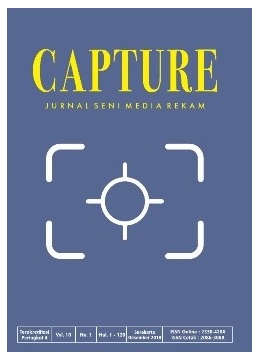COLOR GAME OF ONDEL-ONDEL AS CULTURAL EDUCATION MEDIA FOR CHILDREN
DOI:
https://doi.org/10.33153/capture.v12i1.3263Keywords:
Educational, game, colors, Ondel-Onde, children, , BetawiAbstract
Educational games are a play-while-learning approach for children today, especially in big cities like Jakarta. As an icon of Jakarta, Ondel-Ondel can be found in various corners of Jakarta daily. His familiar figure makes it a suitable subject for learning to color while getting to know about the Betawi culture for children. The Ondel-Ondel coloring application is a multimedia-based educational game designed for children aged 3-7 years, in which information about the elements that make up the attributes of Ondel-Ondel can be inserted. This study combines the educational game implementation method with a user-centered approach, where this method connects the let's draw game with a brief knowledge of Ondel-Ondel as a traditional Betawi art. Analysis of Ondel-Ondel supporting elements or attributes uses Morris Semiotics which focuses on syntax, semantics, and pragmatics by categorizing form, content, and context. This game helps children to get a lot of information about Ondel-Ondel and stimulate their imagination.
Downloads
References
Anggara, I. G. A. S., Santosa, H., & Udayana, A. A. G. B. (2019). Character Education and Moral Value in 2D Animation Film Entitled “Pendeta Bangau.” Capture, 10(2), 57–70. https://doi.org/10.33153/capture.v10i2.2449
Arifin, Y., Martin, M., Ryan, R., & Dratama, R. (2018). Gamification for the Ancient Kingdom of Nusantara with User-Centered Design Approach. ComTech: Computer, Mathematics and Engineering Applications, 9(1), 9–14. https://doi.org/https://doi.org/10.21512/comtech.v9i1.4171
Belton, R. J. (1996). Art History: A Preliminary Handbook (1st ed.). University of British Columbia.
Danesi, M. (2004). Messages, Signs, and Meanings: A Basic Textbook in Semiotics and Communication Theory (3nd ed). Canadian Scholars’ Press Inc.
Dhiva, A. (2016). Tumbuh Kembang Batita. Parentingclub.Co.Id.
Gunawijaya, J. (2001). Wayang Betawi: Prospek dan Tantangan Pengembangan Seni Tradisional. Journal Betawi, 1(November), 20–21.
Morioka, A. (2008). Color Design Workbook (first ed.). Rockport Publishing.
Nordiana, E., & Sugiarto, E. (2013). Perancangan dan Pembuatan Game Pengenalan Warna Berbasis Mobile untuk Anak Usia 2-5 Tahun. Journal of Chemical Information and Modeling, 53(9), 1689–1699. https://doi.org/10.1017/CBO9781107415324.004
Purbasari, M., Marianto, M. D., & Burhan, M. A. (2016). The Dynamic of Betawi in Colors.pdf. Mudra, 31(3), 384–392. https://doi.org/https://doi.org/10.31091/mudra.v31i3.59
Purbasari, M., Marianto, M. D., & Burhan, M. A. (2019). Ondel-Ondel Kekinian: Boneka Besar Betawi di Zaman Modern. Productum: Jurnal Desain Produk (Pengetahuan dan Perancangan Produk), 3(6), 183–188. https://doi.org/10.24821/productum.v3i6.2429
Saputra, Y. A. (2009). Profil Seni Budaya Betawi. Jakarta City Government Tourism and Culture Office.
Suswandari, S. (2017). Local History of Jakarta and Multicultural Attitude (Historical Local Study of Betawi Ethnic). JETL (Journal of Education, Teaching and Learning), 2(1), 93. https://doi.org/10.26737/jetl.v2i1.142
Suyanto, S. (2005). Dasar-Dasar Pendidikan Anak Usian Dini. Hikayat Publishing.
Widyatmojo, G., & Muhtadi, A. (2017). Pengembangan Multimedia Pembelajaran Interaktif Berbentuk Game untuk Menstimulasi Aspek Kognitif dan Bahasa. Jurnal Inovasi Teknologi Pendidikan, 4(1), 38. https://doi.org/10.21831/jitp.v4i1.1019
Downloads
Published
Issue
Section
License
Copyright (c) 2020 Mita Purbasari Wahidiyat

This work is licensed under a Creative Commons Attribution-ShareAlike 4.0 International License.
Copyright
Authors who publish with Capture: Jurnal Seni Media Rekam agree to the following terms:
- Authors retain copyright and grant the journal right of first publication with the work simultaneously licensed under a Creative Commons Attribution License (CC BY-SA 4.0) that allows others to share the work with an acknowledgment of the work's authorship and initial publication in this journal.
- Authors are able to enter into separate, additional contractual arrangements for the non-exclusive distribution of the journal's published version of the work (e.g., post it to an institutional repository or publish it in a book), with an acknowledgment of its initial publication in this journal.







